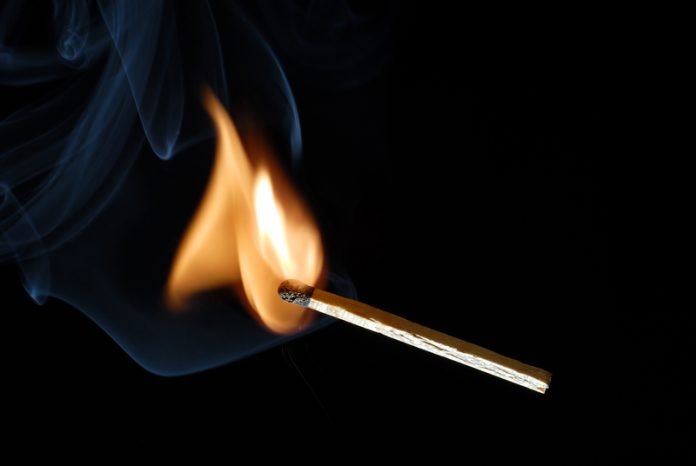Dr. Jimenez Maude, Associate Professor at Lille University outlines how flame retardant coatings can give better protection to major structures such as buildings…
Fire is undoubtedly an emotive subject, especially when it comes to scenarios occurring in a “closed system” (e.g. ship, aircraft or skyscrapers) i.e. where the possibilities to escape are restricted. Everyone remembers the tragic collapse of the twin towers in New York on the 11th of September 2001. Unfortunately, it is one of the most famous examples of a building with poor fire protection, where the steel structure collapsed because of intense fire. Moreover, with the increasing trend of more stringent fire safety regulations, demands for reduction of the fire hazard posed by highly combustible materials, such as plastics have gained importance in recent years. A suitable flame retardant (FR) treatment might be able to retard the ignition of these materials and/or decrease flame spread, thereby preventing fire hazards, loss of life and degradation of property.
Flame retardant coatings, better known as intumescent coatings, can be used successfully both for fire retard plastics and fire protect steel structures, even if these coatings can be different in terms of formulation and thickness (thick coatings are usually used in the fire protection of steel, whereas thin coatings are needed to obtain polymer with acceptable fire retardant properties). These flame retardant coatings constitute one growing branch of the coating industry. However, exposure to long-term environmental conditions can cause these materials to lose some of their functional properties, thus reducing their effectiveness over time. Because fire safety is required throughout the entire life of a building structure, i.e. up to tens of years, it is important to investigate the long-term protection performance of these coatings under exposure to environmental conditions (UV rays, moisture, water, chemicals…). Degradation occurs as the result of environment-dependent chemical or physical attacks, often caused by a combination of degradation agents, and may involve several chemical and physical mechanisms. In order to avoid the decrease of the fire properties of the coating, a topcoat is usually applied. Moreover, the adhesion properties at the coating/substrate interface are usually improved either with a surface pre-treatment or with a primer layer to ensure the good adhesion of the intumescent coating, whatever the substrate (steel or plastic).
Thus, two or three different layers with three specific properties (e.g. adhesive, fire retardant and hydrophobic) are generally needed to provide durable fire retardant capabilities to the polymer or fire resistance to steel. These multilayered systems usually require complex application and curing procedures which are sometimes incompatible with industrial constraints. Indeed, multiple formulation, application and processing steps not only contribute to environmental waste generation and pollution but they also use excessive amounts of energy until a solid film has been produced. In addition, in most cases, including aerospace and industrial maintenance applications, the primer or undercoat must be top-coated within a specific period of time otherwise inter-coat adhesion will be compromised. The processing time could thus be very long with economic consequences. The reduction of the number of layers is highly desirable, so as to form multilayered films from a single coat system that stratifies, while providing equivalent or better overall performance compared to the current systems.
As presented in Figure 1, the self-stratifying approach allows a one-step formation of complex multi-layer or gradient coating structures directly onto plastics or steel, combining optimised surface and adhesion properties in one coating composition.
Figure 1: Flame retardant self-stratifying coatings concept
A homogeneous mixture of incompatible polymers forming a polymer/polymer composite structure is necessary for self-stratifying phenomenon to occur, and the resulting coating should possess unique properties in a wide range of uses. These coatings have been developed mainly for automotive, self-healing and weather-resistant applications, but the self-stratifying approach has never been considered in the fire retardant and fire protection fields. This concept thus constitutes a great possible versatile process for a broad range of fire retardant applications and could thus favor an industrial eco-efficient development of products, taking into account the reduction of solvents and labor cost. A flame-retardant self-stratifying coating would thus completely fit the needs of both the finishing industry in general and the flame retardant coating industry in particular, and opens the door to a real breakthrough and challenge in this field.
The “Self-stratifying Intumescent Coating” or STIC project, funded by the French National Research Agency (ANR), started in 2015 in Lille University. It gathers researchers specialised in the development of flame retardant materials and in the formulation of coatings. First results obtained are extremely promising, as perfect self-stratifying systems have been obtained when applied on plastics, based on fluoropolymer / epoxy resins and silicone / epoxy resins systems. As depicted in Figure 2, type I self-stratifying coatings are obtained, i.e. giving rise to two well distinct and homogeneous layers.
Figure 2: Example of epoxy/silicone self-stratifying coating – Scanning Electron Microscope cross section and EDS analysis in Silicium
The addition of a low percentage of a fire retardant filler allows decreasing drastically the flammability of these coatings, without altering the self-stratification process, leading to a high Limiting Oxygen Index (LOI) of 33vol.% (versus 27 for raw plastic) and a V0 rating at the standardized UL-94 test (versus non classified for raw plastic).
KEY COLLABORATORS
The project gathers two teams of Lille University:
In the Unit of Materials and Transformations (UMET), team Engineering of Polymeric Systems (ISP): Dr. Maude Jimenez (coordinator), Agnès Beaugendre (PhD student), Dr. Mathilde Casetta, Prof. Sophie Duquesne, Dr. Séverine Bellayer and Dr. Stéphanie Degoutin.
In the Unit of catalysis and solid chemistry (UCCS), from the team Molecular Chemistry and Formulation (LCMF): Dr. Christel Pierlot and Dr. Raphaël Lebeuf
FUNDING
French National Research Agency (ANR) – ANRJCJC-14-CE27-0010- STIC
Dr. Jimenez Maude
Associate Professor
Lille University
maude.jimenez@univ-lille1.fr
http://umet.univ-lille1.fr/Polymeres/ index.php?&lang=en
Please note: this is a commercial profile













